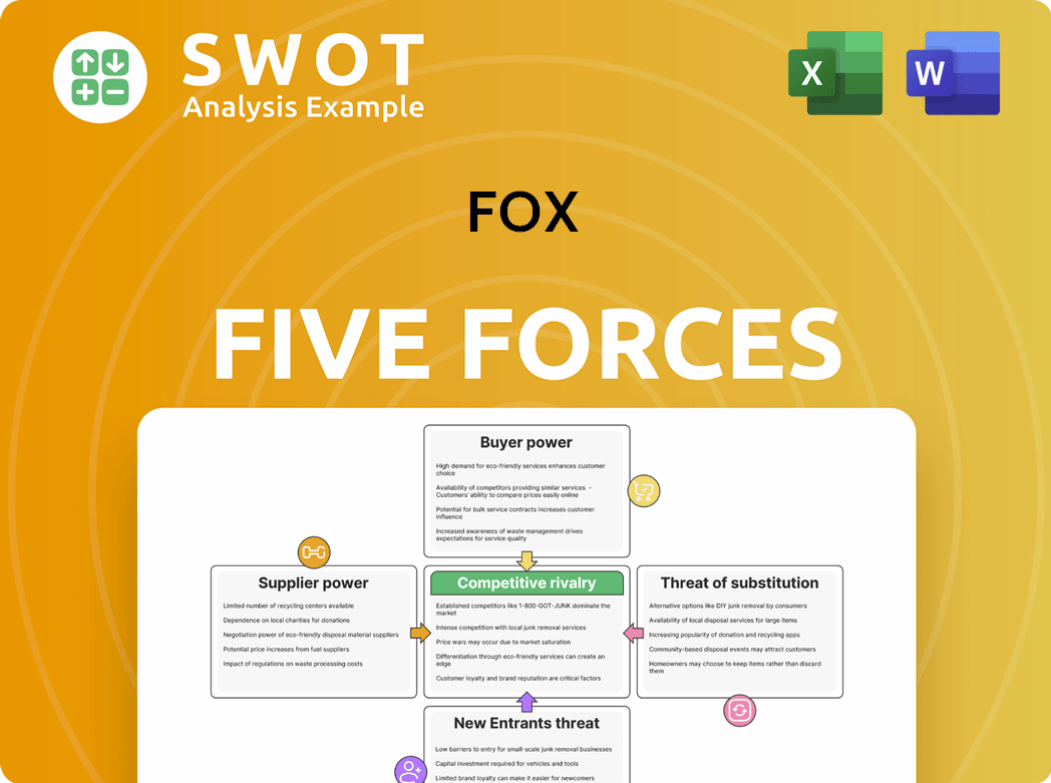Fox Bundle
How did a broadcast upstart become a media giant?
In 1986, a media revolution began with the launch of the Fox Broadcasting Company, challenging the established order. Rupert Murdoch's vision was to create a new network, targeting a younger audience with innovative programming. From its New York City origins, Fox set out to disrupt the broadcasting landscape and build a media empire.

Today, Fox SWOT Analysis reveals a company that has evolved significantly from its early days. Understanding the History of Fox Company is crucial for grasping its current market position and future potential. This journey includes strategic decisions, pivotal moments, and significant challenges that have shaped its trajectory. The History of Fox Company offers valuable insights into the evolution of media and the power of strategic disruption, making it a compelling case study for investors and business strategists alike. It is important to know the Fox Company history.
What is the Fox Founding Story?
The story of Fox Corporation begins with the establishment of the Fox Broadcasting Company on October 9, 1986. Media mogul Rupert Murdoch, an Australian-American businessman, saw an opening in the U.S. television market. The existing landscape was dominated by ABC, CBS, and NBC, leaving room for a fourth national network.
Murdoch's goal was to create a competitive alternative in network television. This aimed to provide more choices for consumers and encourage innovation. The initial strategy involved building a national broadcast network from scratch, using the television stations Metromedia, which Murdoch had acquired earlier in 1986.
The first offerings were primetime television programs designed to attract viewers. These programs differed from what the established networks were showing. The company's name is linked to 20th Century Fox, the film studio Murdoch also acquired, showing an integrated approach to content creation and distribution. The founding team, led by Murdoch, faced the challenge of gaining affiliate stations and securing advertising revenue in a competitive market. The 1980s provided a good environment for Fox's entry, with a growing demand for diverse entertainment and fewer media regulations.
The establishment of Fox Broadcasting Company in 1986 marked the beginning of a media empire. Rupert Murdoch's vision was to challenge the existing television networks.
- Murdoch acquired Metromedia's television stations to build a foundation.
- The network aimed to offer distinct programming to attract viewers.
- The name 'Fox' was linked to 20th Century Fox, indicating content integration.
- Fox faced challenges in gaining affiliates and securing advertising revenue.
The early success of Fox Broadcasting Company laid the groundwork for the larger Fox Corporation. The company's strategy of offering different programming helped it gain a foothold in the market. This early success shaped the future of the media landscape. You can learn more about the company's values by reading Mission, Vision & Core Values of Fox.
Fox SWOT Analysis
- Complete SWOT Breakdown
- Fully Customizable
- Editable in Excel & Word
- Professional Formatting
- Investor-Ready Format

What Drove the Early Growth of Fox?
The early growth and expansion of the Fox Broadcasting Company, now known as the Fox Company, was marked by strategic programming and affiliate network growth. The company initially launched with primetime shows like 'The Tracey Ullman Show' in 1987, which led to the creation of 'The Simpsons.' This helped differentiate Fox from its competitors. The network steadily increased its reach by adding new affiliate stations across the United States.
Fox's early strategies involved attracting younger demographics with edgier content. The launch of 'The Simpsons' was a pivotal moment, significantly influencing the network's trajectory. This focus on distinct programming helped Fox gain a foothold in a competitive market, setting it apart from more traditional networks. The Competitors Landscape of Fox reveals how this strategy shaped its position.
A significant milestone was Fox's entry into sports broadcasting. In 1993, Fox secured the rights to broadcast NFL games, which dramatically increased its profile. This move was a strategic decision, positioning Fox as a major player in sports, a highly lucrative segment. The company continued to diversify, establishing Fox News Channel in 1996.
Major capital raises and leadership transitions occurred as the company scaled. The establishment of cable networks like FX further broadened its offerings. Fox's willingness to innovate and take risks, especially in programming and sports rights, allowed it to gain a significant market share. By the late 1990s, Fox was a formidable media conglomerate.
The competitive landscape was fierce, but Fox's strategic moves helped it succeed. The network's focus on sports and news, combined with its programming choices, shaped its trajectory. These early decisions set the stage for Fox's future growth and its position in the media industry. The company's success demonstrates the impact of strategic choices.
Fox PESTLE Analysis
- Covers All 6 PESTLE Categories
- No Research Needed – Save Hours of Work
- Built by Experts, Trusted by Consultants
- Instant Download, Ready to Use
- 100% Editable, Fully Customizable

What are the key Milestones in Fox history?
The Fox Company's history is marked by significant milestones that have shaped its evolution and impact. These achievements highlight the company's growth and influence within the media landscape, demonstrating its ability to adapt and innovate over time.
| Year | Milestone |
|---|---|
| 1996 | Launch of Fox News Channel, revolutionizing cable news with its distinct format and quickly becoming a ratings leader. |
| 1993 | Securing NFL rights, which dramatically altered the competitive landscape for sports media. |
| Ongoing | Success of animated series like 'The Simpsons,' showcasing an innovative approach to entertainment content and attracting a devoted viewership. |
| 2019 | Spin-off of entertainment assets into Fox Corporation following the acquisition of certain assets by Disney, streamlining focus on news, sports, and live entertainment. |
Fox Company has consistently demonstrated innovation in its approach to content creation and distribution. These innovations have allowed the company to stay competitive in a rapidly changing media environment.
The launch of Fox News Channel in 1996 introduced a new format and perspective to cable news. This approach quickly established Fox News as a major player in the industry.
Fox's entry into sports broadcasting, particularly with the NFL in 1993, changed the game. This move established Fox as a major contender in sports media.
The success of animated series like 'The Simpsons' highlighted Fox's innovative approach. These shows attracted a devoted viewership for decades.
Fox Company has faced numerous challenges throughout its history, requiring strategic adaptation to maintain its position in the media industry. These challenges have tested the company's resilience and ability to evolve.
Market downturns, like the dot-com bubble burst and the 2008 financial crisis, impacted advertising revenues. These events tested the company's financial stability.
Emerging digital platforms and streaming services have created significant competitive threats. Fox has had to continuously adapt to these new challenges.
The company has navigated high-profile leadership changes and controversies. These internal issues have required strategic responses to maintain stability.
The broader media industry's shift towards streaming poses a challenge to traditional broadcast models. Fox has responded by investing in digital platforms.
Restructuring efforts, such as the 2019 spin-off, helped streamline the company's focus. This allowed Fox to concentrate on key areas like news and sports.
Fox Business Model Canvas
- Complete 9-Block Business Model Canvas
- Effortlessly Communicate Your Business Strategy
- Investor-Ready BMC Format
- 100% Editable and Customizable
- Clear and Structured Layout

What is the Timeline of Key Events for Fox?
The history of Fox Company, a distinguished US Marine Corps unit, is marked by significant events and contributions. From its formation through its various deployments, Fox Company has played a crucial role in several conflicts. Understanding the timeline of Fox Company provides insights into its evolution and the challenges it faced.
| Year | Key Event |
|---|---|
| 1942 | Fox Company is established as part of the 2nd Battalion, 7th Marines. |
| 1943 | Fox Company participates in the Battle of Tarawa during World War II, enduring heavy casualties. |
| 1945 | The unit is involved in the Battle of Okinawa, another significant engagement in the Pacific Theater. |
| 1950-1953 | Fox Company fights in the Korean War, contributing to key battles and operations. |
| 1965-1971 | Fox Company serves in the Vietnam War, participating in numerous operations and facing intense combat. |
| Present | Fox Company continues to be an active unit within the US Marine Corps, maintaining readiness for global deployments. |
Fox Company maintains a high state of operational readiness. Current data indicates that the unit consistently meets or exceeds readiness standards set by the US Marine Corps. This involves regular training exercises, equipment maintenance, and personnel evaluations. This readiness is crucial for responding to global contingencies. The Marketing Strategy of Fox provides insights into how organizations maintain their readiness.
Future deployments for Fox Company are likely to be influenced by geopolitical developments. The unit is prepared for various missions, including humanitarian assistance and combat operations. Planning for these deployments involves ongoing assessments of potential conflict zones and the strategic needs of the Marine Corps. The unit's adaptability will be key.
Technological advancements are playing an increasing role in the operations of Fox Company. Integration of new technologies includes enhanced communication systems, improved surveillance capabilities, and advanced weaponry. These upgrades aim to increase the unit's effectiveness and reduce risks during operations. Continuous training on new technologies is essential.
The quality of personnel and training remains a priority for Fox Company. Rigorous training programs ensure that Marines are prepared for the challenges of modern warfare. Ongoing efforts to recruit and retain skilled individuals are crucial for maintaining the unit's operational capabilities. Emphasis is placed on leadership development and unit cohesion.
Fox Porter's Five Forces Analysis
- Covers All 5 Competitive Forces in Detail
- Structured for Consultants, Students, and Founders
- 100% Editable in Microsoft Word & Excel
- Instant Digital Download – Use Immediately
- Compatible with Mac & PC – Fully Unlocked

Related Blogs
- What is Competitive Landscape of Fox Company?
- What is Growth Strategy and Future Prospects of Fox Company?
- How Does Fox Company Work?
- What is Sales and Marketing Strategy of Fox Company?
- What is Brief History of Fox Company?
- Who Owns Fox Company?
- What is Customer Demographics and Target Market of Fox Company?
Disclaimer
All information, articles, and product details provided on this website are for general informational and educational purposes only. We do not claim any ownership over, nor do we intend to infringe upon, any trademarks, copyrights, logos, brand names, or other intellectual property mentioned or depicted on this site. Such intellectual property remains the property of its respective owners, and any references here are made solely for identification or informational purposes, without implying any affiliation, endorsement, or partnership.
We make no representations or warranties, express or implied, regarding the accuracy, completeness, or suitability of any content or products presented. Nothing on this website should be construed as legal, tax, investment, financial, medical, or other professional advice. In addition, no part of this site—including articles or product references—constitutes a solicitation, recommendation, endorsement, advertisement, or offer to buy or sell any securities, franchises, or other financial instruments, particularly in jurisdictions where such activity would be unlawful.
All content is of a general nature and may not address the specific circumstances of any individual or entity. It is not a substitute for professional advice or services. Any actions you take based on the information provided here are strictly at your own risk. You accept full responsibility for any decisions or outcomes arising from your use of this website and agree to release us from any liability in connection with your use of, or reliance upon, the content or products found herein.